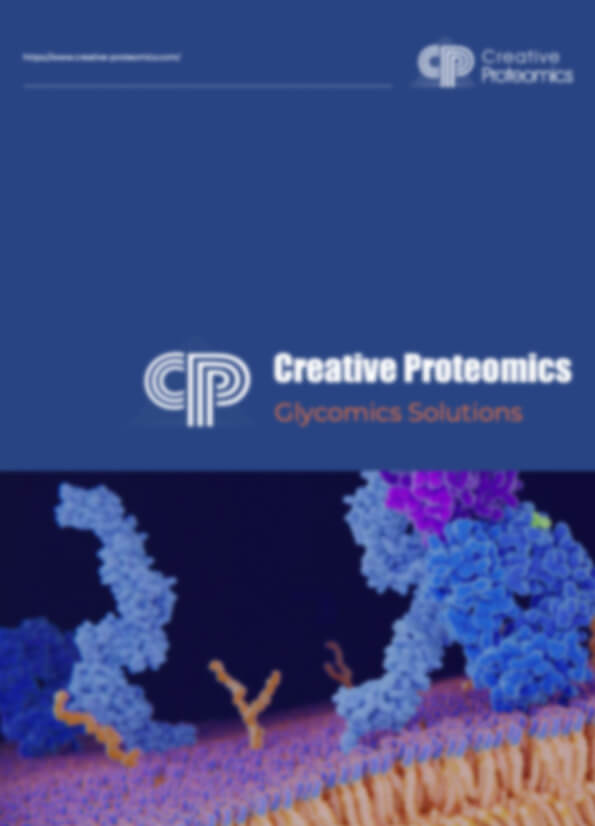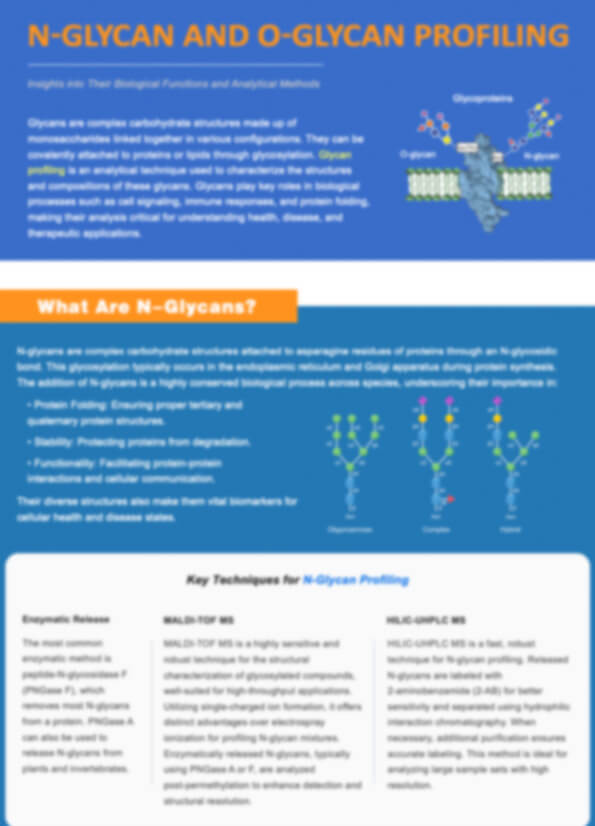Lactose Analysis Service
Creative Proteomics offers lactose analysis services, specializing in trace-level quantification, isomer differentiation, and structural elucidation. We support both basic biology and industrial applications, helping businesses optimize product quality, ensure accurate research data, and resolve issues related to lactose impurities, degradation, and stability in complex matrices like dairy, plant-based products, and pharmaceuticals.
Submit Your Request Now
×- What We Provide
- Advantages
- Technology Platform
- Sample Requirements
- FAQ
- Publications
What is Lactose?
Lactose, a disaccharide composed of glucose and galactose linked by a β-1,4-glycosidic bond, is the primary carbohydrate in mammalian milk. It plays a critical role in energy provision and serves as a precursor for bioactive molecules such as lactosylceramide, a glycosphingolipid involved in cellular signaling and membrane integrity. Accurate analysis of lactose and its derivatives is essential for understanding its biochemical interactions, optimizing dairy product quality, and advancing research in metabolic pathways.
Lactose Analysis Service Offered by Creative Proteomics
Comprehensive Lactose Profiling
- Trace-Level Quantification: Detect lactose down to 0.01 ppm using HPAE-PAD-MS (Agilent 6470) and LC-MS/MS (Thermo Fisher Q Exactive).
- Isomer Differentiation: Achieve ≥99% accuracy in identifying α-lactose and β-lactose using chiral column HPLC (Shimadzu Nexera X2) and NMR.
- Multi-Platform Validation: Ensure data reliability with cross-verification using HPAE-PAD-MS.
Structural Elucidation
- Glycosidic Bond Mapping: Differentiate β-1,4 and β-1,6 linkages using MS/MS fragmentation with Orbitrap Exploris 480 at 240,000 resolution.
- Lipid-Bound Lactose Analysis: Identify and quantify lactosylceramide species for neurodegenerative research using LC-QTOF.
- Isotopic Labeling: Apply 13C-lactose labeling for sensitive detection across a range of 0.1 to 500 μg/mL.
Impurity and Degradation Analysis
- Impurity Detection: Quantify galactose, epilactose, and fructose.
- Degradation Kinetics: Assess lactose stability under pH 2–12 and various temperatures to predict shelf-life.
- Matrix-Specific Cleanup: Use 2D chromatography to remove interfering compounds in complex matrices like plant-based milk and baked goods.
List of Detectable Lactose-Related Metabolites
| Category | Metabolite | Detection Capability |
|---|---|---|
| Lactose & Isomers | Lactose Monohydrate, Anhydrous Lactose | High Sensitivity |
| Lactose Derivatives | Galactose, Glucose | Quantitative & Qualitative |
| Degradation Products | 5-Hydroxymethylfurfural (5-HMF), Organic Acids | Trace-Level Detection |
| Related Sugars | Maltose, Sucrose, Trehalose | Specificity Assured |
Advantages of Lactose Assay
- Comprehensive Analysis: Using HPAE-PAD-MS, NMR, and UPLC-MS/MS, we provide accurate quantification, isomer differentiation, and structural analysis of lactose and its derivatives.
- High Efficiency: Our automated systems handle up to 200 samples per day with minimal manual input. 2D chromatography ensures reliable results even for complex samples like dairy or plant-based products.
- Tailored Solutions: We customize methods for specific applications, including lactose detection in plant-based foods, fermentation monitoring, and cosmetic ingredient analysis.
- Actionable Insights: Beyond raw data, we deliver insights like stability predictions, metabolic pathway analysis, and crystallinity evaluation to support product development and quality control.
- Reliable Results: Advanced algorithms detect anomalies in data, ensuring accurate and consistent results for both research and industrial applications.
Technology Platforms for Lactose Analysis Service
HPAE-PAD-MS (Agilent 6470): High-performance anion-exchange chromatography with pulsed amperometric detection, providing trace-level lactose quantification.
LC-MS/MS (Thermo Fisher Q Exactive): Sensitive and accurate for detecting lactose metabolites and impurities in complex matrices.
HPLC-RI (PerkinElmer Series 200): Reliable quantification of lactose and isomers using refractive index detection.
Orbitrap Exploris 480: High-resolution MS for glycosidic bond mapping and structural elucidation at 240,000 resolution.

Thermo Fisher Q Exactive (Figure from Thermo)

Agilent 6470 Triple Quadrupole LC/MS System (Figure from Agilent)
Sample Requirements for Lactose Analysis Service
| Sample Type | Minimum Volume Required | Storage Conditions | Additional Notes |
|---|---|---|---|
| Dairy Products (Milk, Cheese, Yogurt) | 50 mL or 50 g | -20°C, avoid repeated freeze-thaw | Homogenized samples preferred. |
| Plant-Based Milk and Beverages | 50 mL | -20°C | Ensure no preservatives or additives interfere. |
| Fermentation Broth | 20 mL | -80°C | Provide detailed process information if available. |
| Serum, Plasma, or Biological Fluids | 500 µL | -80°C | Collect in anticoagulant-free tubes. |
| Food Formulations and Baked Goods | 50 g | -20°C | Grind or homogenize solid samples before storage. |
| Pharmaceutical Formulations | 10 mL or 10 g | Room Temperature or as per label | Provide formulation composition for accurate analysis. |
Applications of Lactose Assay Service
Biopharmaceutical Production
Monitor lactose as a stabilizer or excipient in drug formulations and ensure batch-to-batch consistency.
Bioprocess Optimization
Track lactose utilization in cell culture media for recombinant protein and monoclonal antibody production.
Basic Biological Research
Study lactose metabolism, transport mechanisms, and enzyme activities in microbial, animal, and plant systems.
Quality Control in Food and Dairy Industry
Verify lactose content, ensure label accuracy, and detect impurities in dairy and lactose-free products.
Fermentation Process Monitoring
Analyze lactose consumption and by-product formation in microbial fermentation for enzyme, bioethanol, and organic acid production.
Stability and Storage Studies
Evaluate lactose degradation in pharmaceuticals, food, and beverages under varying storage conditions.
Demo
FAQ of Lactose Analysis Service
How can I determine if the sensitivity of the lactose analysis method meets my requirements?
Our HPAE-PAD-MS (Agilent 6470) achieves a detection limit as low as 0.01 ppm, ideal for trace-level lactose analysis in low-lactose dairy products. For higher lactose concentrations (≥1%), HPLC-RI (PerkinElmer Series 200) provides a cost-effective and reliable option. We tailor the analysis method based on your sample matrix and detection goals.
Will extreme temperatures or acidic conditions affect lactose analysis results?
Yes, lactose can degrade under harsh conditions, forming by-products like lactobionic acid. We offer lactose degradation kinetics analysis using LC-MS/MS under simulated storage conditions (pH 2-12, 25-60°C) to predict product stability and provide formulation optimization insights.
Can you analyze lactose in plant-based samples like oat milk or soy milk?
Yes, we specialize in plant-based product analysis. Using 2D-IC for effective impurity removal and ¹³C-labeled lactose internal standards for matrix effect correction, we ensure accurate lactose quantification in challenging samples with detection ranges from 0.01 to 1000 ppm.
Is it possible to analyze lactose and human milk oligosaccharides (HMOs) in a single test?
Absolutely. Our combined HPAE-PAD and high-resolution MS methods allow simultaneous quantification of lactose and HMOs (e.g., 2'-FL, LNnT). Structural insights into glycosidic linkages, such as β-1,3/1,6 bonds.
Does the sample require protein or fat removal before lactose analysis?
Sample preparation depends on the matrix:
- Dairy products and serum: Centrifugation (10,000×g, 10 min) for fat removal and acetonitrile precipitation for protein removal.
- Fermentation broth and plant extracts: Simple 0.22 µm filtration is typically sufficient.
We provide tailored sample preparation protocols for optimal results.
Can lactose analysis results support lactose intolerance research?
Yes. We quantify lactose and its enzymatic hydrolysis products (glucose and galactose) to assess lactase enzyme activity. Additionally, we analyze fermentation by-products like short-chain fatty acids (SCFAs) in gut models to evaluate probiotic efficacy and lactose-free product performance.
What key data are included in the lactose analysis report?
Our comprehensive reports include:
- Quantitative Results: Accurate lactose concentrations.
- Chromatograms and Spectra: Visual confirmation of peak purity and separation.
- Stability Assessment: Predictive shelf-life models using Arrhenius equation.
- Isomer Composition: α/β lactose ratios and hydration states.
Can lactose be analyzed in mixtures with other sugars like sucrose or maltose?
Yes, using CAD (Charged Aerosol Detection) for lactose quantification and MS for sugar identification, we achieve precise separation of lactose from common interfering sugars with a resolution of ≥2.0.
How long does the lactose analysis process take?
Turnaround time depends on the sample type and analysis complexity. Standard lactose quantification typically takes 5-7 business days, while structural analysis or impurity profiling may require 7-10 days. Expedited services are available upon request.
Can you analyze lactose in pharmaceutical excipients?
Yes. We ensure compliance with pharmaceutical quality standards by analyzing lactose in excipients for content uniformity, impurity identification, and degradation monitoring. Methods like HPAE-PAD-MS and HPLC-RI are employed for precise results.
How do you ensure the accuracy and reproducibility of results?
We apply strict quality control measures including:
- Use of certified reference standards and isotopically labeled internal standards.
- Cross-validation using multiple platforms (HPAE-PAD-MS, HPLC-RI, LC-MS/MS).
- Duplicate analysis and spike recovery tests to ensure reproducibility.
Learn about other Q&A.
Lactose Analysis Service Case Study
Publications
Here are some of the glycomics-related papers published by our clients:

- Identification of the O-Glycan Epitope Targeted by the Anti-Human Carcinoma Monoclonal Antibody (mAb) NEO-201. 2022. https://doi.org/10.3390/cancers14204999
- Modulation of the Endomembrane System by the Anticancer Natural Product Superstolide/ZJ-101. 2023. https://doi.org/10.3390/ijms24119575
- Conformational differences between functional human immunodeficiency virus envelope glycoprotein trimers and stabilized soluble trimers. 2019. https://doi.org/10.1128/jvi.01709-18
- Alternative glycosylation controls endoplasmic reticulum dynamics and tubular extension in mammalian cells. 2021. https://doi.org/10.1126/sciadv.abe8349
References
- Sacks, Cody, and KATHERINE STUMPO. Gold Nanoparticles for Enhanced Laser Desorption/Ionization of Biomolecules. Diss. University of Scranton, 2018.
- Valgimigli, Luca, Simone Gabbanini, and Riccardo Matera. "Analysis of maltose and lactose by U-HPLC-ESI-MS/MS." (2012). https://doi.org/10.1039/9781849734929-00443













